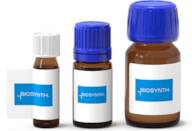
CBL-B (22-37) Heavy
Ref. 3D-CRB1300943
| 25nMol | 452,00 € |
Produktinformation
- H-ILGIIDAIQDAVGPPK^-OHILGIIDAIQDAVGPP-[U-13C6,15N2-Lys]-acidH-Ile-Leu-Gly-Ile-Ile-Asp-Ala-Ile-Gln-Asp-Ala-Val-Gly-Pro-Pro-[U-13C6
- 15N2-Lys]-OH
CBL-B (22-37) is derived from the CBL-B E3 ubiquitin ligase which targets receptor tyrosine kinases to lysosome degradation. CBL-B and its family member CBL are expressed in hematopoietic cells and as E3 ubiquitin ligases they contain a tyrosine kinase domain and an RF domain joined by a linker domain. The function of the RF domain is to transfer ubiquitin from E2 ubiquitin-conjugating enzymes onto the target protein which is often phosphorylated. Consequently the ubiquitinated substrate, the receptor tyrosine kinases, are ultimately targeted to the lysosome for degradation.EGFR is an example of a receptor tyrosine kinase whose activation is prevented by CBL and CBL-B when they bind and recruit GRb2, the adapter protein to EGFR. Consequently the ubiquitinylation of EGFR occurs and targets it for recognition by the endosomal protein complex and then lysosome degradation.It has also been found that the CBL family can negatively regulate through ubiquitinylation, PI 3-kinases, Rap G-protein guanine nucleotide exchange factor (GEF), C3G and Rho GTPase GEF Vav which are all non-receptors.If CBL or CBL-B becomes non-functional it can be associated with malignancies such as acute mye-loid leukemia and myelodysplastic syndrome.The lysine residue at position 16 is isotopically labelled with carbon-13 (6) and nitrogen-15 (2).
Chemische Eigenschaften
Technische Anfrage zu: 3D-CRB1300943 CBL-B (22-37) Heavy
Wenn Sie ein Angebot anfordern oder eine Bestellung aufgeben möchten, legen Sie stattdessen die gewünschten Produkte in Ihren Warenkorb und fordern Sie dann ein Angebot oder eine Bestellung an aus dem Warenkorb. Es ist schneller, billiger und Sie können von den verfügbaren Rabatten und anderen Vorteilen profitieren.





